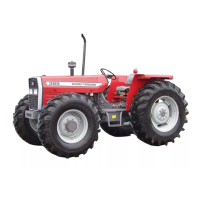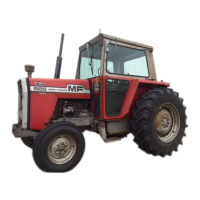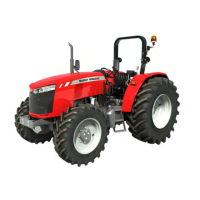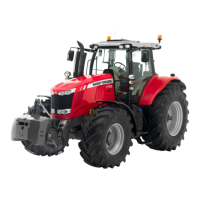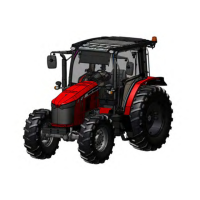MASSEY.FERGUSON
TECUMSEH
ETVG'A'ES
MODEL H7O
GROUP
O-SECTION V-PART
8
so that tapered
end of shaft extends
through bearing
in
cylinder.
12.
Rotate
crankshaft
so
crankshaft
journal
engages
bearing of
connecting rod. Position connecting
rod cap
on connecting
rod
and
secure with two washers and
two self-locking
nuts.
13.
Lubricate
bearing surfaces of camshaft and
install
camshaft in
cylinder, making sure match marks
on
camshaft
gear
are aligned with match marks on
crank-
shaft
gear
(Fig.
5).
Timing
mark on cam
gear
will
always be found
adjacent to locating hole in
gear
face.
Timing
mark
on crank
gear
will always be found
ad-
jacent
to locating
pin in crankshaft. This will aid
re-
assembly by relieving pressure
between camshaft
lobes
and valve lifters,
as well as
providing
correct
timing
for valves
in relation
to crankshaft.
14.
Install
cylinder cover.
15.
Install
crankshaft oil seal
in
cylinder. To
install
seal, position
sleeve
tool,
(Fig.
5) on
end
of
crankshaft.
Slide oil
seal over
sleeve
tool, then, with sleeve
tool
still in place,
drive
oil
seal in place with oil seal driver,
so that
oil seal is
squarely
positioned in bottom of oil
seal
seat.
Remove driver and sleeve tool.
16.
Install
magneto and flywheel.
PISTON,
PISTON
RINGS AND CONNECTING
ROD
l.
Remove
cylinder head and scrape any carbon
from
upper cylinder
bore
and
head.
2.
Remove
cylinder
cover
as described in
"Cylinder
Cover".
3. Rotate
crankshaft
until crankshaft and
camshaft
gear
timing
marks are aligned
(Fig.
5), then
remove
camshaft.
4. Remove
selfJocking
nuts
and
washers from con-
necting
rod
bolts; remove rod
caps
from
connecting
rod.
5. Push
assembled
connecting rod and
piston as-
sembly
out
of cylinder.
6.
Remove
three piston rings, carefully inspecting
rings as
they
are removed to note identifying
mark
on
the top ring.
The top and the
middle
ring
are
identical,
with top
ring
acting
as a compression
ring
and
the
middle ring
as
a scraper
ring.
The
perforated
bottom
ring is
an
oil ring.
Lay
rings
aside in order
removed
for easy
identification.
(Recent
production
models
do
not
use identifying
marks.)
7.
Remove
snap fit retaining rings
from
piston with
long-nosed
pliers.
Remove
piston pin
to separate
piston
and connecting
rod.
8. Clean
and
inspect
piston,
piston rings and con-
necting
rod
as follows:
a. Wash
all parts
in solvent.
Use
particular care to
remove
all carbon from ring lands
and
grooves
of
piston.
This can easily
be done
with
dressed
end
of
old ring.
b. Check
cylinder
bore diameter with
an
accurate
micrometer.
If
it
is worn, cylinder will have to be
4
h,+-.'.'.:!J'
rebored, as described in
"Reboring
the Cylinder"
and oversized
piston
and
rings
will be
required.
c. If cylinder is within
dimension limits indicated
in
"Specifications",
insert
each
ring,
in turn,
into
cylinder
bore.
Insert the piston into the
cylinder
bore to make sure the piston
ring is squarely in the
bore, Fig. 6. Measure ring
gap
with
a feeler
gauge
as shown
in
Fig.
7.
Ring
gap
should be as indicated
F,g.
7
in
"Specifications".
If
ring
gap
is
greater
than in-
dicated,
replace
rings.
NOTE:
Rings must aluays be replaced
in
sets,
neoer singlg.
Because
of the lou cost of
rings,
it is
adaisable
to
replace rings
taheneper the
engine
is
distnantled.
d.
Inspect
piston
for
wear or scoring.
If
it is scored,
or
worn beyond limits
indicated in
"Specifications",
piston and pin
assernbly should be replaced.
e. Inspect
new ring
in proper ring
groove
of
piston
and check side clearance
between
land
of
piston
and
ring
with a feeler
gauge.
If dimensions are
not
within specified limits, replace piston
and
pin
assembly.
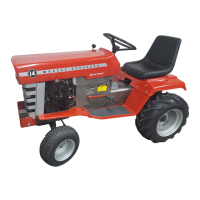
